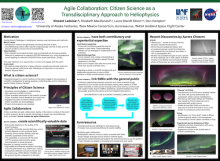Agile Collaboration: Citizen Science as a Transdisciplinary Approach to Heliophysics
Vincent
Ledvina
University of Alaska Fairbanks
Poster
Citizen science connects scientists with the public to enable discovery, engaging broad audiences across the world. There are many attributes that make citizen science an asset to the field of heliophysics, including agile collaboration. Agility is the extent to which a person, group of people, technology, or project can work efficiently, pivot, and adapt to adversity. Citizen scientists are agile; they are adaptable and responsive. Citizen science projects and their underlying technology platforms are also agile by utilizing beta testing and short timeframes to pivot in response to community needs. As they capture scientifically valuable data, citizen scientists can bring expertise from other fields to scientific teams. The impact of citizen science projects and communities means citizen scientists bridge scientists and the public, facilitating the exchange of information. These attributes of citizen scientists form the framework of agile collaboration. In this seminar, we will contextualize agile collaboration with a primary focus on aurora chasers—a group of citizen scientists actively engaged both in projects and independent data gathering—using the NASA citizen science project Aurorasaurus as an example of successful collaboration. Ways in which citizen science may be applied to many areas of heliophysics will be presented. Solving current Heliophysics grand challenges will require novel and innovative methods, and agile collaboration with citizen scientists is integral to such solutions.

Poster PDF
Poster category
Ionosphere and Thermosphere Research and Applications
Poster session day
Poster location
31
Meeting homepage